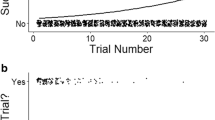Abstract
Young goldfish were individually housed in large containers (Part 1), individually housed in small containers (Part 2), or housed in large containers in groups of five (Part 3). The fish were run in sets of five fish (five fish simultaneously in an activity-conditioning chamber). Thus, the fish had to compete for the large or small US that was dropped in the water following a 10-sec. CS (light). Fish in each part comprised groups LS (large US in the first phase of training and small US in the second phase of training), LL, SL and SS. All LS groups showed downward shifts in activity and negative contras effects (lower activity levels than SS control fish). None of the SL groups produced complete upward shifts in activity. Group-housed fish in Part 3 showed larger increases in activity to the CS than individually housed fish in Parts 1 and 2.
Similar content being viewed by others
References
BITTERMAN, M.E. 1966. Animal learning. In J.B. Sidowski (Ed.), Experimental methods and instrumentation in psychology. New York: McGraw-Hill.
BREUNING, S.E., & WOLACH, A.H. 1977. Successive negative contrast effects with goldfish (Carassius auratus). The Psychological Record, 27, 565–575.
COCHRANE, T.L., SCOBIE, S.R., & FALLON, D. 1973. Negative contrast in goldfish (Carassius auratus). Bulletin of the Psychonomic Society, 1, 411–413.
GONZALEZ, R.C., POTTS, A., PITCOFF, K., & BITTERMAN, M.E. 1972. Runway performance of goldfish as a function of complete and incomplete reduction in amount of reward. Psychonomic Science, 27, 305–307.
LOWES, G., & BITTERMAN, M.E. 1967. Reward and learning in the goldfish. Science, 157 456–457.
MACKINTOSH, N. J. 1971. Reward and aftereffects of reward in the learning of goldfish. Journal of Comparative and Physiological Psychology, 76, 225–232.
RAYMOND, B., ADERMAN, M., & WOLACH, A. H. 1972. Incentive shifts in the goldfish. Journal of Comparative and Physiological Psychology, 78, 10–13.
WOLACH, A.H., RAYMOND, B., & HURST, J. W. 1973. Reward magnitude shifts with goldfish. The Psychological Record, 23, 371–376.
WILLIAMS, J. L. 1970. Effects of the duration of a secondary reinforcer on subsequent instrumental responses. Journal of Experimental Psychology, 2, 348–351.
WOLF, J. B. 1936. Effectiveness of token rewards for chimpanzees. Comparative Psychological Monographs, 12 (Serial No. 60).
Author information
Authors and Affiliations
Rights and permissions
About this article
Cite this article
Breuning, S.E., Wolach, A.H. Successive Negative Contrast Effects for Activity-Conditioned Goldfish (Carassiusauratus) as a Function of Housing Conditions. Psychol Rec 29, 245–254 (1979). https://doi.org/10.1007/BF03394610
Published:
Issue Date:
DOI: https://doi.org/10.1007/BF03394610




